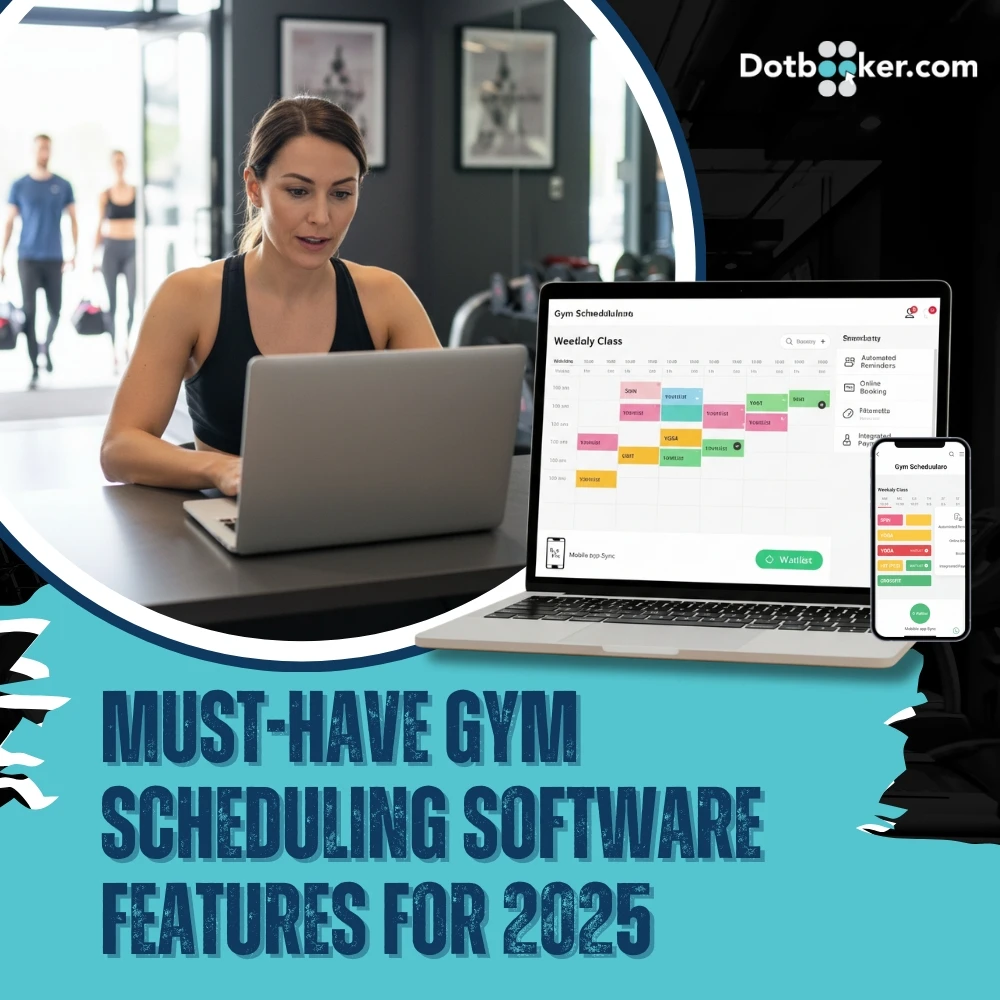
- By Dotbooker
- Oct 06, 2025
- 458
Must-Have Gym Scheduling Software Features for 2025
Think about it: when members walk into your gym, what they truly value isn’t just the equipment or the trainers—it’s time. Time to squeeze in a spin class before work. Time to catch a yoga session during lunch. Time to train without waiting in line for a treadmill. In 2025, time is the ultimate currency, and gyms that respect it win.
This is where gym software has quietly stepped into the spotlight. What used to be an afterthought—scribbled notes, messy rosters, or receptionist-managed bookings—has now evolved into a polished, real-time experience. Scheduling isn’t just an admin task anymore; it’s the heartbeat of a thriving fitness business.
From Scribbles to Smart Systems: The Evolution of Gym Scheduling
Picture the old days: a crowded noticeboard outside the studio, names crossed out, last-minute calls to confirm slots. Chaos was common, and frustration even more so. Fast forward to today, where gym management software replaces confusion with clarity.
One glance at a mobile app now tells a member everything they need to know—available classes, open equipment, even which trainer is free. The jump from manual to digital hasn’t just streamlined scheduling; it has elevated the member experience into something gyms can proudly market.

Real-Time Booking: Because No One Likes to Wait
Consider a member who wants to attend a 6 AM yoga class before work. They open their gym’s app, see available spots, and confirm their booking in seconds. That instant confirmation is no small thing—it’s peace of mind. They don’t have to call the front desk or worry about being turned away.
For gyms, real-time booking reduces staff workload and builds trust. Members who feel confident their reservation is secure are more likely to stay engaged. And this applies not just to classes, but also to equipment reservations, personal training sessions, or even wellness add-ons like physiotherapy pods. In 2025, real-time booking isn’t optional—it’s the baseline expectation.
Smart Reminders: Turning Forgetfulness into Consistency
Even the most motivated members get distracted by life. A missed alarm, a late meeting, or simple forgetfulness can mean skipped sessions. For gyms, every no-show is a lost opportunity—both in revenue and in member satisfaction.
That’s why automated reminders are powerful. The best fitness studio software sends friendly nudges across multiple channels—emails, texts, or app notifications—reminding members of upcoming sessions. These reminders reduce cancellations and keep attendance steady.
Imagine a push notification the night before: “Your 7 AM Spin Class is ready. Don’t forget your water bottle!” That one line doesn’t just prevent a no-show; it reinforces consistency, which is exactly what members crave in their fitness journey.
Multi-Site and Multi-Trainer Scheduling Made Simple
As gyms expand, scheduling complexity multiplies. One trainer may handle classes across two locations. Members may hold memberships that allow cross-location access. Without a unified system, scheduling across multiple sites is a logistical nightmare.
Modern gym management software centralizes everything. Managers can oversee trainer schedules, balance room usage, and track class bookings across all branches from one dashboard. Members, in turn, can view availability across locations and book wherever it suits them.
This level of coordination creates a seamless experience: trainers aren’t double-booked, members aren’t left guessing, and managers aren’t scrambling. It’s the difference between a disorganized chain and a professional fitness brand.
Book and Pay in One Flow
Think of how people shop online—they add to the cart, pay, and get confirmation instantly. Why should gym bookings be any different? Members today expect to book a class and pay for it in one step.
With integrated payments, gym software eliminates barriers. Members can purchase class packs, renew memberships, or pay per session directly while booking. For gyms, this means no chasing after payments and no lost revenue.
It’s also about trust. Secure, seamless payments reassure members that their gym is professional and reliable—qualities that encourage long-term loyalty.
The Self-Service Advantage
Nobody likes waiting in line at the reception desk to cancel a class. Members want freedom. Self-service portals and mobile apps give them exactly that—control over their bookings, cancellations, and reschedules.
For busy professionals, this is priceless. Picture someone getting stuck in a late office meeting—they simply open the app, reschedule their personal training session, and avoid a missed appointment. The member is happy, and the trainer doesn’t lose a slot.
This freedom reduces staff intervention, keeps members satisfied, and positions the gym as forward-thinking.
Waitlists That Keep Classes Full
Every gym has those high-demand classes—whether it’s spin, HIIT, or Zumba—that fill up almost instantly. Without a waitlist, members who miss out feel left behind. With smart waitlist management, they join a queue and get notified the moment a spot opens.
For gyms, this means fewer empty seats when cancellations happen. For members, it means hope and fairness—no more calling reception repeatedly to check for openings.
A smart waitlist ensures that every class runs at full capacity, maximizing both member experience and revenue.
Analytics: Turning Data into Strategy
Behind every schedule is a pattern. Some classes always run full, others struggle to attract members. Certain trainers consistently drive attendance, while some time slots remain underused. Without data, gyms are guessing.
Analytics built into fitness studio software changes that. Managers can see when the gym is busiest, which classes are most popular, and which trainers generate the highest engagement. With this knowledge, they can optimize schedules, invest in the right resources, and even design targeted promotions.
Data-driven decisions transform scheduling from an operational function into a strategic growth tool.
Hybrid and Virtual: The Future-Proof Model
The pandemic reshaped fitness habits. Even as gyms reopened, members grew accustomed to virtual classes. Many now prefer a hybrid model—attending in person some days, joining online on others.
Forward-thinking gym software accommodates both. Members can book in-person spots, access live-streamed sessions, or catch up with recorded classes—all within the same platform. This flexibility expands a gym’s reach and appeals to modern fitness lifestyles.
Gyms that embrace hybrid scheduling aren’t just keeping up with the times—they’re future-proofing their business.
Staff Scheduling That Connects to Payroll
It’s not just members who need structure—staff do too. Trainers and instructors often work on complex schedules, with some paid hourly, some per class, and others on commission. Without automation, tracking this is messy and error-prone.
When scheduling integrates with payroll, every class taught and every shift worked is automatically logged. Trainers get paid accurately, disputes are avoided, and managers save countless hours of manual calculation.
This alignment strengthens trust between gyms and their teams, building a workplace culture that supports both staff and members.

Customization That Reflects Your Brand
Every gym has its own personality. Some focus on hardcore strength training, others on holistic wellness. That individuality should shine through in the member experience.
Customizable scheduling tools let gyms create branded portals, set their own cancellation policies, and design experiences that match their identity. It’s not just about functionality—it’s about building loyalty by reinforcing brand trust at every touchpoint.
Staying Ahead with Smarter Scheduling
In 2025, scheduling isn’t a background task—it’s the stage on which the entire gym experience plays out. From real-time booking to analytics, from hybrid classes to staff payroll, the right features turn scheduling into a powerful engine for growth.
This is where Dotbooker excels. Designed for fitness businesses that want to combine efficiency with experience, Dotbooker integrates bookings, payments, reminders, and insights into one seamless platform. It’s not just software—it’s a partner in delivering the kind of member experience that keeps people coming back.
When time is the most valuable thing your members own, giving them a smarter way to manage it is the ultimate way to stand out.
Popular Blogs

- Oct 20, 2022
- 4651

- Sep 08, 2024
- 3959

- Nov 11, 2022
- 3408

- Sep 16, 2024
- 2792
Transform your business now!

Get an expert consultation for your business's streamlined operations.